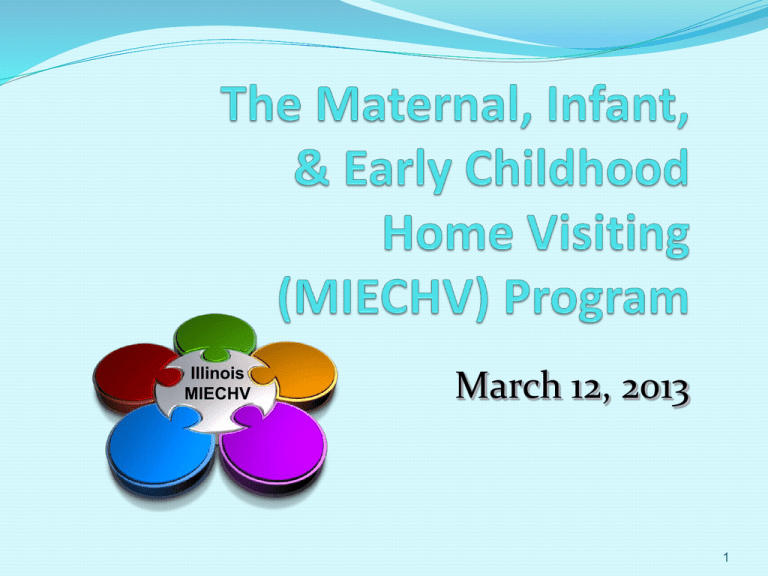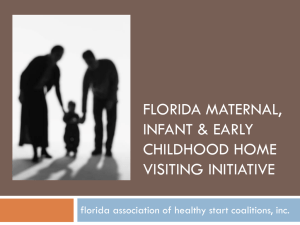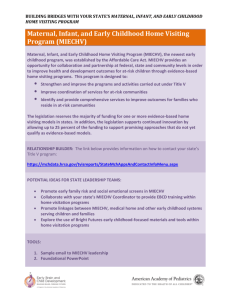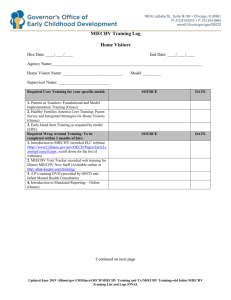MIECHV Presentation - Partner. Plan. Act.
advertisement

Illinois MIECHV March 12, 2013 1 Today’s Outline Overview of Home Visiting and MIECHV in Illinois Background: federal MIECHV goals and requirements Q&A Illinois MIECHV Past (timeline) Present (direct services and community systems) Future (building home visiting systems statewide) 2 What is Home Visiting? A Home Visiting program uses trained home visitors to provide direct services to pregnant women or children from birth to age 5. Home Visiting services are free and voluntary. Home Visitors have received background checks as well as extensive training in child development. Home Visitors share information about parent-child interactions, and they model activities to stimulate attachment and development. There are ~300 Home Visiting programs in Illinois. 3 What is MIECHV? MIECHV = Maternal, Infant, & Early Childhood Home Visiting program. MIECHV is a federally funded program, carried out by states and community agencies. In Illinois 6 communities were funded, based on need, and capacity of established home visiting programs and existing early childhood collaborations. Englewood/West Englewood/ Greater Grand Crossing, Cicero, Elgin, Rockford, Macon County, Vermilion County. 4 Overview of Illinois MIECHV HV Models Model Target Population Healthy Families America (HFA) Families at risk of child abuse and neglect (birth to 5) Nurse Family Partnership (NFP) First-time low income moms, ideally enrolled at 16-20 weeks (no later than 28 wks) (through age 2) Early Head Start (EHS) Low-income pregnant women and - home based option families with children from birth through age 3 Parents As Teachers (PAT) Prenatal - 5 years 5 Federal MIECHV Goals Strengthen and improve Title V (maternal and child health) programs. Improve coordination of services in at-risk communities. Provide comprehensive home visiting services to improve outcomes in at-risk communities. Increase intra-agency collaboration. Review evidence-based models. Conduct national evaluation (MIHOPE) for Congress. 6 Federal MIECHV Requirements Conduct needs assessments. Prioritize high risk populations. Use evidence-based home visiting models with fidelity. Show improvement in mandated (required) benchmark areas. Submit annual data reports. Demonstrate state maintenance of effort (same level of funding) for home visiting programs. 7 Federally-Recognized Evidence-Based Models 1. 2. 3. 4. 5. 6. 7. Healthy Families America Child First Early Head Start— Home Based Option Early Intervention Program for Adolescent Mothers Family Check-Up Healthy Steps Parents as Teachers 8. 9. 10. 11. 12. 13. http://homvee.acf.hhs.gov/ Home Instruction for Parents of Preschool Youngsters Nurse Family Partnership Play and Learning Strategies Infant The Early Start (New Zealand) Oklahoma CommunityBased Family Resource and Support Program SafeCare Augmented 8 Federally Mandated Benchmarks 1. Improved maternal and newborn health* 2. Reduced incidence of child maltreatment, child injuries and ER visits* 3. Increased school readiness and achievement 4. Reduced domestic violence or crime* 5. Improved family economic self-sufficiency 6. Improved coordination and referrals for other community resources and supports* 9 Federal Program Requirements Appropriate oversight and administration Implementation plan, including a timeline State plan for Continuous Quality Improvement (CQI) and use of data systems Voluntary services Partnerships and collaboration Illinois MIECHV 10 Illinois MIECHV: The Past Needs assessments (September 2010) Updated State Plans (June 2011) FY 2011 Formula Applications (July 2011) FY 2012 Formula Awards (September 2012) Competitive (Research) Awards (July 2011) 11 Illinois MIECHV Competitive Grant Three funded research projects: Doula Randomized Control Trial (University of Chicago) Doula Expansion (Ounce of Prevention Fund) Fussy Baby Network Enhancement Training (Erikson Institute and Chapin Hall) 12 Illinois MIECHV Formula Grant Expand or enhance one or more evidence-based models of home visiting Ensure that the home visiting program is effectively connected to community based organizations and services Establish a system of universal screening and coordinated intake in target areas Enhance or establish an early childhood collaborative in target areas 13 HRSA Region V MIECHV State Home Visiting Models Illinois HFA, NFP, EHS, PAT Indiana HFA, NFP Michigan HFA, NFP, EHS Minnesota HFA, NFP Ohio HFA, NFP Wisconsin HFA, EHS, NFP (Healthy Families America, Nurse Family Partnership, Early Head Start- Home based option, Parents As Teachers) 14 Illinois MIECHV Formula Grants A collaboration is funded in 6 high-risk communities: Englewood, West Englewood, Greater Grand Crossing* Elgin* Rockford Cicero Macon County* Vermilion County* Roles within each collaboration: Home Visiting Coordinated Intake Community Systems Development * These 4 communities are included in the national MIHOPE evaluation. 15 Illinois Formula Grant Services include: Mobile (animated DVD project) Infant Mental Health Consultation Linkages to Medical Homes (ICAAP) 4 P’s Plus screening (substance abuse, tobacco, depression) Abriendo Puertas - Opening Doors (Latino parent engagement) Learning Communities Strong Foundations Training: Domestic Violence Substance Abuse Mental Health Parents with Special Needs Community Systems and Capacity Building 16 Illinois MIECHV Community Systems: Community Systems Development staff in each community Collective Impact model Key components of systems development include: Operating structure Communication and trust; participatory meetings Comprehensive membership list Shared vision statement Inventory of community services Community needs assessment and strategic plan Joint activities Evaluation 17 Constructs (Measures) for Benchmark #6: Improved Coordination and Referrals 1. 2. 3. 4. 5. Increase or maintain the proportion of families assessed for primary medical care, basic needs, ATOD, DV, mental health, behavioral health, child developmental delays, education, employment, and housing within one year of enrollment. Increase or maintain the proportion of families with identified service needs who are referred to available services within one month of receiving a positive screening. An increase in the proportion of families referred for services that complete the referral. An increase in the number of community agencies with which the home visiting provider has an identified contact person. An increase in the number of community agencies with which the home visiting provider has established formal MOUs for the coordination of services and exchange of information. 18 Illinois MIECHV At A Glance Between March 1st – September 30th, 2012 MIECHV Coordinated Intake screened over 1,000 women. Illinois MIECHV served 555 families. The average age of pregnant and postpartum* women was 22.37 years old with a range of 13 to 45 years old. 15.5% of pregnant and post-partum* women were positive for possible domestic violence. 22.5% of pregnant and post-partum* women were positive for depressive symptoms. *Postpartum is defined as 6 weeks post birth 19 Illinois MIECHV: The Future Incorporating Non-MIECHV Communities In MIECHV communities, we are working with non- MIECHV home visiting partners to be part of Coordinated Intake. We are looking for non-MIECHV communities who will volunteer to incorporate Coordinated Intake into their home visiting system . We are working to offer MIECHV trainings to nonMIECHV staff. We want to support non-MIECHV communities in strengthening collaborations. 20 For more information, please contact: Joanna Su, M.S.W. Manager of Community Systems and Capacity-Building Governor’s Office of Early Childhood Development (312) 814-6741 Joanna.Su@illinois.gov 21










